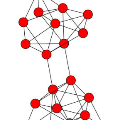Network-structured data becomes ubiquitous in daily life and is growing at a rapid pace. It presents great challenges to feature engineering due to the high non-linearity and sparsity of the data. The local and global structure of the real-world networks can be reflected by dynamical transfer behaviors among nodes. This paper proposes a network embedding framework to capture the transfer behaviors on structured networks via deep prediction models. We first design a degree-weight biased random walk model to capture the transfer behaviors on the network. Then a deep network embedding method is introduced to preserve the transfer possibilities among the nodes. A network structure embedding layer is added into conventional deep prediction models, including Long Short-Term Memory Network and Recurrent Neural Network, to utilize the sequence prediction ability. To keep the local network neighborhood, we further perform a Laplacian supervised space optimization on the embedding feature representations. Experimental studies are conducted on various datasets including social networks, citation networks, biomedical network, collaboration network and language network. The results show that the learned representations can be effectively used as features in a variety of tasks, such as clustering, visualization, classification, reconstruction and link prediction, and achieve promising performance compared with state-of-the-arts.
翻译:网络结构数据在日常生活中变得无处不在,并且正在快速增长。由于数据高度非线性和广度,它给工程特征带来了巨大的挑战。现实世界网络的本地和全球结构可以通过节点之间的动态传输行为反映出来。本文件提议了一个网络嵌入框架,以通过深层预测模型在结构网络上捕捉传输行为。我们首先设计一个有一定程度的偏向随机行走模型,以捕捉网络上的传输行为。然后引入一个深层网络嵌入方法,以保持节点之间的转移可能性。一个网络结构嵌入层被添加到传统的深层预测模型中,包括长期短期记忆网络和经常性神经网络,以利用序列预测能力。为了保持本地网络的周边,我们进一步在嵌入特征图上进行拉普拉普奇人监督的空间优化。对各种数据集进行了实验性研究,包括社会网络、引用网络、生物医学网络、协作网络和语言网络。结果显示,在各种任务中,例如集群、可视化、重新分类、业绩和状态预测中,可以有效地将所学表现作为特征作为特征的特征特征特征特征的特征,比较。



